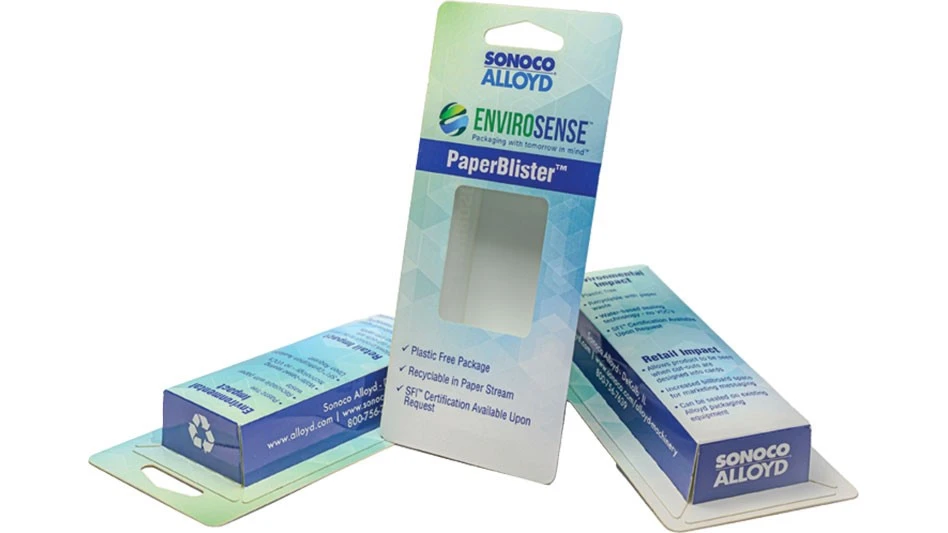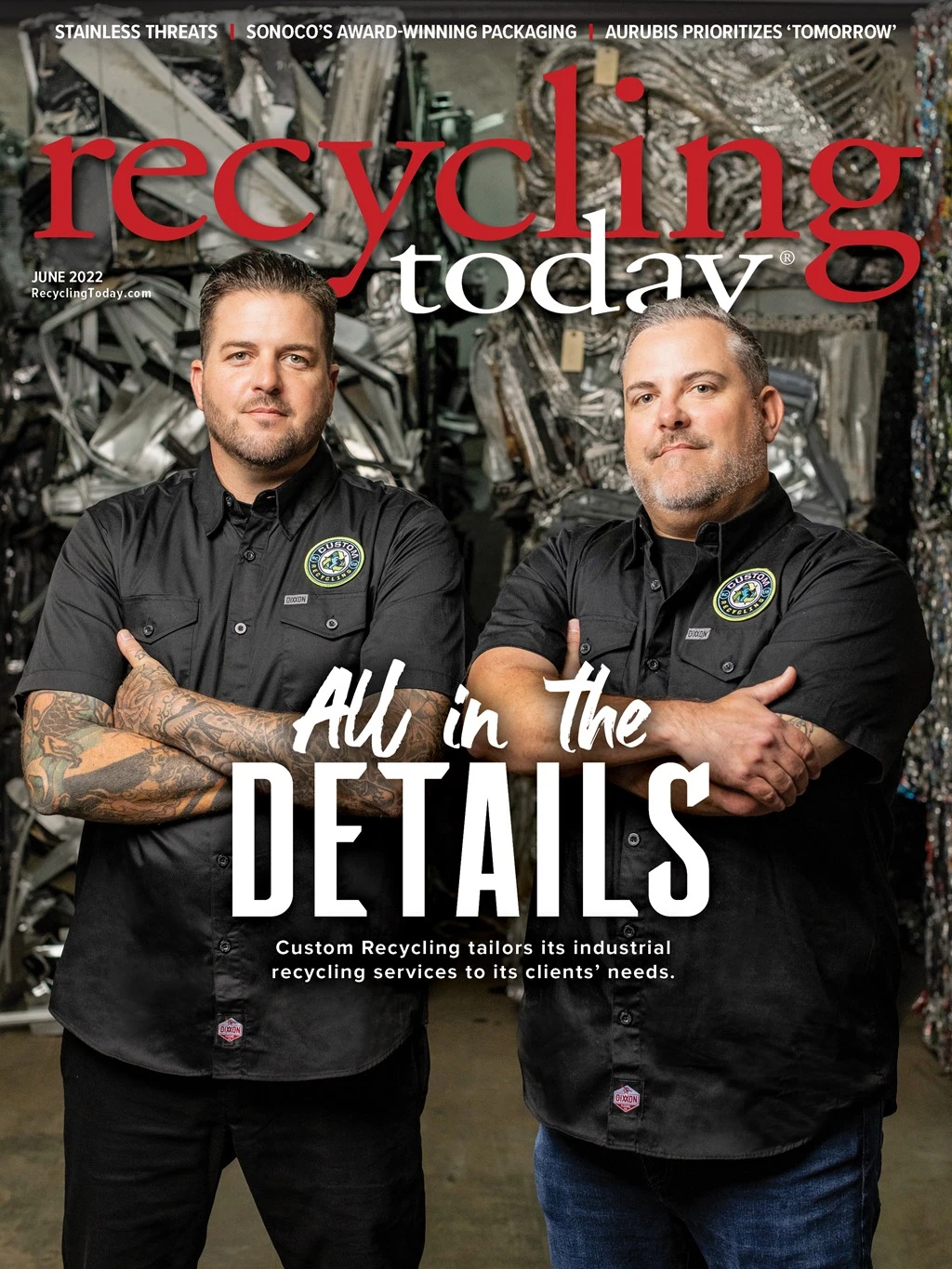

Sonoco Alloyd, a unit of Hartsville, South Carolina-based packaging producer Sonoco, has made waves in the packaging sector with its award-winning EnviroSense PaperBlister packaging—most recently being honored with the Design for Recycling Award at the Institute of Scrap Recycling Industries (ISRI) Convention & Exposition in March.
It’s the latest in a line of several major industry recognitions, including the American Forest & Paper Association’s 2021 Innovation in Sustainability Award and the Sustainable Packaging Coalition’s 2021 SPC Innovator Award in the category of Innovation in Design Optimization.
The EnviroSense PaperBlister is part of Sonoco’s greater EnviroSense packaging portfolio, which features products that offer a specific set of criteria: recyclable, compostable, responsible fiber sourcing, reusable, recycled content, packaging optimization, reduced environmental impact and/or bio-based content. To qualify, a product must meet some combination of these criteria.
Sonoco says the portfolio also encompasses a range of packaging materials, including rigid paper containers with 100-percent-postconsumer-recycled (PCR) content, monomaterial flexible pouches and plastic containers, as well as packaging made from agricultural fibers, such as sugarcane.
But the EnviroSense PaperBlister was born from the growing intent to reduce the amount of plastic in packaging, says Eric Clamp, commercial development manager at Sonoco and lead business strategist for the EnviroSense PaperBlister package.
“Now that everybody is intent upon at least considering what the change is and how it’s going to impact their productivity, their operations, etc., we were able to make the change to converge that plastic piece into a paper substitution,” he says.
Thoughtful design
Once the engineering and research processes began, the product development took nine months to a year, Clamp says. He adds that much of what Sonoco produces is plastic blister packaging, so plenty of adjustments were needed when it came to developing a fiber-based option.
Clamp describes the traditional blister package as a card, or a solid bleached sulfate (SBS) structure, that seals to a plastic blister, or tray, with a flange on the edge of the blister that seals to a coating activated on the card by heat, time and pressure.
“We thought we could replace it,” Clamp says. “It’s not a new theory. It’s been out there for a long time; it just hasn’t been adopted.”
Clamp says many packaging companies have been making the transition from using virgin SBS board to using recycled material in their products, adding, “there have been recycled options in the marketplace for decades.”
On the plastics side, he says companies have gone from traditionally using polyvinyl chloride (PVC) to polyethylene terephthalate (PET), then converting to recycled PET before finding a paper solution. “Some people are jumping straight from PVC to a paper blister, and others have a kind of stepped approach to replacement,” Clamp says.
He adds that several factors need to be considered before a product manufacturer makes the transition from one material to another, including cost, manufacturing and operations—what equipment does a facility currently have on its line and how cost-prohibitive will it be to replace it if necessary?
It was important for Sonoco to ease that transition for its customers. Clamp says the company makes the equipment traditionally used to seal blister packaging and, in most cases, can modify the equipment already on the floor with a conversion kit. “We’re not completely disrupting their operations,” Clamp says.
Sabrina Dixon-Ridges, global sustainability business strategy alignment manager at Sonoco, says because PCR fiber varies in availability and cost, especially with the supply chain disruptions over the course of the COVID-19 pandemic, the materials used in the paper blister vary between virgin and PCR.
The recyclability was more important than anything, with Dixon-Ridges adding, “What’s really good about this is being able to add a solution that did not increase the cost for the consumer.”
The EnviroSense PaperBlister is what Sonoco calls “material agnostic.” Sonoco can supply virgin material as well as PCR-blended material, and Clamp says when Sonoco offers a PCR paper blister it contains about 70 percent PCR content—a standard PCR blend offering.
Clamp says he and his team at Sonoco wanted the transition to its paper blister to be as seamless as possible for manufacturers, thereby making sustainable and recyclable packaging more accessible. “For us, it’s a selling feature,” he says. “It’s a value proposition when we’re having conversations about this because, Sabrina’s right—postconsumer materials can be more expensive than virgin materials. Sometimes those costs make it a little bit more difficult for those that are really pressed to watch their pennies or pinch their pennies, and they may not want to change.”
He adds, “[Now] it’s a little bit easier because the cost differential between paper and PET, PVC [or] whatever they’re using, it’s usually a lot closer.”

Equal opportunities
The Sonoco team designed its EnviroSense PaperBlister not only with recyclability in mind but with durability as well—as a consumer product package and as it makes its way through the supply chain. Clamp says the packaging has three points of protection within the transportation chain as the product travels from manufacturer to retailer.
“Rarely do we see any damage with traditional or normal shipping of products like this, packing on the manufacturing line and as they make their way through distribution,” he says.
He adds that, compared with traditional plastic blister packaging, the EnviroSense PaperBlister also provides equal potential to protect a product.
“In most cases, the product itself is not heavy, it’s not expensive, it’s not too fragile in nature,” Clamp says.
He adds that some primary products within the packaging might have glass, sensitive areas or plastic around them, but that the paper allows for protection. Placing that primary package into a secondary pack, then putting it in a master carton, provides those three points of protection to ensure product quality has not been compromised in favor of package recyclability.
With freight rates continuing to rise, the design team also considered how it could make the most of each delivery by designing the paper blister packaging so it could be more efficiently stacked and transported. Sonoco says its lightweight paper blister package is easier to nest and stack and uses less material than traditional thermoformed plastic blisters, allowing more packages per truckload to reduce shipping costs and to decrease the environmental footprint.
“There is a freight consideration to this,” Clamp says. “When you talk about sustainability, there’s a little bit of a story there as well for freight savings.”
He continues, “It also helps the manufacturer at the point of packaging [because] there’s less touch points because I could put more into the machinery at one time. So, I’m working the machine less; I’m not loading the machine as much as I normally would, so there are some additional man-hour savings that you get out of it as well.”
Consumer appeal and addressing concerns
The increased attention to reducing plastic waste drove the Sonoco team to turn to a fiber-based option. Dixon-Ridges says it was important for the paper blister to use sustainably sourced materials—whether virgin or PCR—to ease consumers’ minds as they made their purchases.
“We understand that consumers have an affinity for paper-based packaging when they’re concerned about the environment,” Dixon-Ridges says. “For them to know it has an end of life, it really does appeal to consumers.”
While the desire for sustainability is increasing among consumers, a 2020 study conducted by McKinsey & Co., a New York-based research firm— “Sustainability in packaging: Inside the minds of U.S. consumers”—suggests U.S. consumers rank sustainability low when it comes to what drives purchases but that the majority want to see more recyclable and recycled-plastic packaging as well as fiber-based substitutes.
According to the study, U.S. consumers ranked hygiene and food safety, shelf life, ease of use, durability, information on the label and appearance over environmental impact.
Clamp says some brands are concerned about losing sell-through and brand loyalty because, compared with traditional plastic packaging, with the paper blister, a consumer is unable to see through the package to view the product.
“The biggest challenge is when you look at plastic, it’s visible. It’s open to the naked eye. You don’t have any challenges or interpretations of what the product looks like,” Clamp says. “When you start introducing paper, you can reproduce the product graphically, which has its benefits, and then you can also die cut the card, or open up the card to show the physical product as well.”
He adds, “American consumers have been buying folding cartons with pictures on it and die cuts on it for years. So, they’ll adopt it, it’s just at a rate at which we don’t understand yet because it’s not prevalent yet in the marketplace.
“[A]s a general consumer, my preference is to support those efforts and initiatives that are better for the environment,” Clamp adds. “We just have to get over the hump of adoption and how long it’s going to take for all Americans to accept that this is the new structure that my product is going to be [in] when it’s typically under $10. There’s molded pulp fiber that’s out there, and then you’ve got folding cartons and then paper blisters that are now replacing those structures as well.”
Ultimately, Dixon-Ridges says the paper blister’s compatibility with current recycling infrastructure is what sets the product apart and, though less familiar than a traditional plastic blister, the attribute gives it an edge when it comes to long-term sustainability.
“The paper stream or the fiber stream is a well-established recycling stream, both from curbside collection [and] even postindustrial or drop-off collection sites,” she says. “The [recycling] infrastructure supports various types of paper products, [and] the PaperBlister is completely compatible with that infrastructure. … And then it’s processed completely compatible within the recycled fiber processing system, so you don’t have to wait; it’s a solution for today—for right now.”

Explore the June 2022 Issue
Check out more from this issue and find your next story to read.
Latest from Recycling Today
- Cyclic Materials to build rare earth recycling facility in Mesa, Arizona
- Ecobat’s Seculene product earns recognition for flame-retardant properties
- IWS' newest MRF is part of its broader strategy to modernize waste management infrastructure
- PCA reports profitable Q1
- British Steel mill subject of UK government intervention
- NRC seeks speakers for October event
- LME identifies Hong Kong warehouses
- Greenville, Mississippi, launches aluminum can recycling program





